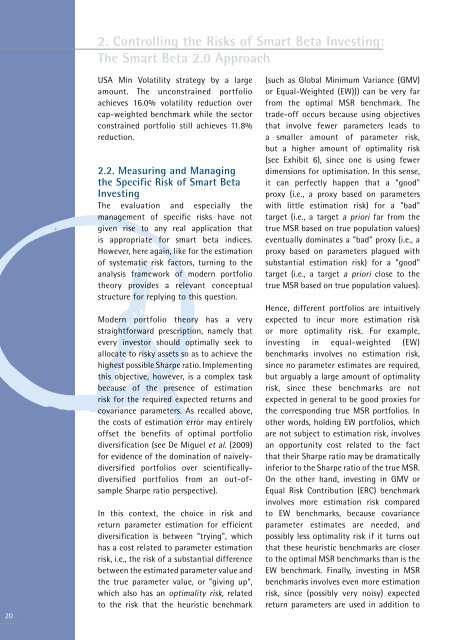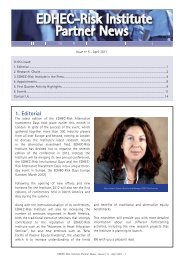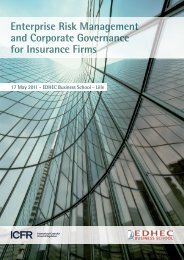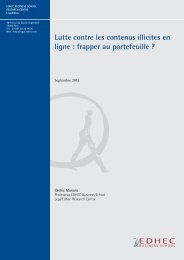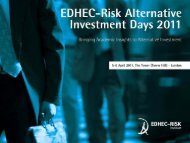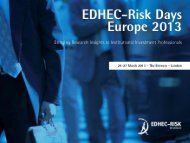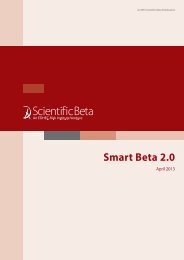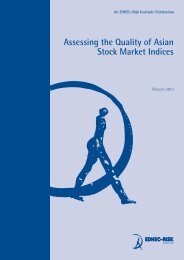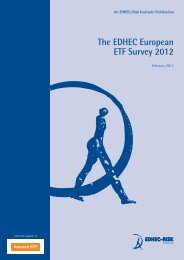Smart Beta 2.0 - EDHEC-Risk
Smart Beta 2.0 - EDHEC-Risk
Smart Beta 2.0 - EDHEC-Risk
Create successful ePaper yourself
Turn your PDF publications into a flip-book with our unique Google optimized e-Paper software.
2. Controlling the <strong>Risk</strong>s of <strong>Smart</strong> <strong>Beta</strong> Investing:<br />
The <strong>Smart</strong> <strong>Beta</strong> <strong>2.0</strong> Approach<br />
20<br />
USA Min Volatility strategy by a large<br />
amount. The unconstrained portfolio<br />
achieves 16.0% volatility reduction over<br />
cap-weighted benchmark while the sector<br />
constrained portfolio still achieves 11.8%<br />
reduction.<br />
2.2. Measuring and Managing<br />
the Specific <strong>Risk</strong> of <strong>Smart</strong> <strong>Beta</strong><br />
Investing<br />
The evaluation and especially the<br />
management of specific risks have not<br />
given rise to any real application that<br />
is appropriate for smart beta indices.<br />
However, here again, like for the estimation<br />
of systematic risk factors, turning to the<br />
analysis framework of modern portfolio<br />
theory provides a relevant conceptual<br />
structure for replying to this question.<br />
Modern portfolio theory has a very<br />
straightforward prescription, namely that<br />
every investor should optimally seek to<br />
allocate to risky assets so as to achieve the<br />
highest possible Sharpe ratio. Implementing<br />
this objective, however, is a complex task<br />
because of the presence of estimation<br />
risk for the required expected returns and<br />
covariance parameters. As recalled above,<br />
the costs of estimation error may entirely<br />
offset the benefits of optimal portfolio<br />
diversification (see De Miguel et al. (2009)<br />
for evidence of the domination of naivelydiversified<br />
portfolios over scientificallydiversified<br />
portfolios from an out-ofsample<br />
Sharpe ratio perspective).<br />
In this context, the choice in risk and<br />
return parameter estimation for efficient<br />
diversification is between "trying", which<br />
has a cost related to parameter estimation<br />
risk, i.e., the risk of a substantial difference<br />
between the estimated parameter value and<br />
the true parameter value, or "giving up",<br />
which also has an optimality risk, related<br />
to the risk that the heuristic benchmark<br />
(such as Global Minimum Variance (GMV)<br />
or Equal-Weighted (EW))) can be very far<br />
from the optimal MSR benchmark. The<br />
trade-off occurs because using objectives<br />
that involve fewer parameters leads to<br />
a smaller amount of parameter risk,<br />
but a higher amount of optimality risk<br />
(see Exhibit 6), since one is using fewer<br />
dimensions for optimisation. In this sense,<br />
it can perfectly happen that a "good"<br />
proxy (i.e., a proxy based on parameters<br />
with little estimation risk) for a "bad"<br />
target (i.e., a target a priori far from the<br />
true MSR based on true population values)<br />
eventually dominates a "bad" proxy (i.e., a<br />
proxy based on parameters plagued with<br />
substantial estimation risk) for a "good"<br />
target (i.e., a target a priori close to the<br />
true MSR based on true population values).<br />
Hence, different portfolios are intuitively<br />
expected to incur more estimation risk<br />
or more optimality risk. For example,<br />
investing in equal-weighted (EW)<br />
benchmarks involves no estimation risk,<br />
since no parameter estimates are required,<br />
but arguably a large amount of optimality<br />
risk, since these benchmarks are not<br />
expected in general to be good proxies for<br />
the corresponding true MSR portfolios. In<br />
other words, holding EW portfolios, which<br />
are not subject to estimation risk, involves<br />
an opportunity cost related to the fact<br />
that their Sharpe ratio may be dramatically<br />
inferior to the Sharpe ratio of the true MSR.<br />
On the other hand, investing in GMV or<br />
Equal <strong>Risk</strong> Contribution (ERC) benchmark<br />
involves more estimation risk compared<br />
to EW benchmarks, because covariance<br />
parameter estimates are needed, and<br />
possibly less optimality risk if it turns out<br />
that these heuristic benchmarks are closer<br />
to the optimal MSR benchmarks than is the<br />
EW benchmark. Finally, investing in MSR<br />
benchmarks involves even more estimation<br />
risk, since (possibly very noisy) expected<br />
return parameters are used in addition to


